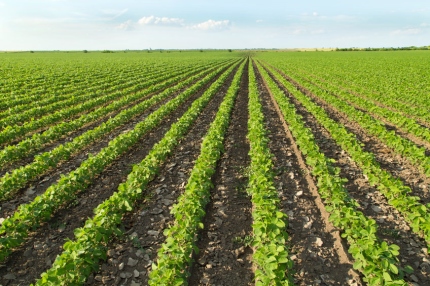This Farmland REIT Just Raised Its Dividend By 20%
There is an asset class that’s worth around $3 trillion in the United States, yet it's completely ignored by Wall Street and is rarely on investors’ radar screens. The asset class I’m talking about is farmland.

There are already a lot of people to feed—about 7.9 billion—and that number is increasing all the time. By 2050, the global population may reach about 9.7 billion and will require our farmland to be even more productive than it is today.
The forecast population growth is why the United Nations’ Food and Agriculture Organization (FAO) estimates that global food production needs to increase by about 70% by 2050, just to be able feed all the people.
Farmland Disappearing
Those numbers emphasize the importance of arable land, and the U.S. has some of the best arable land in the world. Here is some information pulled from a recent report by AcreTrader:
"The U.S. contains over 900 million acres of farmland, about 250 million of which produce the cereal crops that are so key to global diets.
"In 2020, U.S. farms produced about 4.2 tons of coarse grain per acre. That is more than a ton more than the next highest-producing country (Argentina) and over double the global average."
The problem is that this rich soil is being paved over and used for something other than farming. As the report notes: “Globally, a 2015 University of Sheffield research study found that, around the world, we had lost a third of our arable land in about 40 years.”
Unfortunately, the U.S. is part of that trend. The report continues: “A 2020 study by the American Farmland Trust calculated that we lose about 2.9 acres per minute of arable land. Much of this land is lost to urban and suburban development. Between 1992 and 2012, more than half of urban and suburban growth happened on agricultural land, converting about 31 million acres to developed uses.”
That makes the farmland that is still left more and more valuable - and it’s why many well-heeled investors are snapping up U.S. farmland.
Farmland as an Investment
Bill Gates is the largest owner of farmland in the United States, having previously purchased 242,000 acres of farmland in 19 states. His largest land holdings are in Louisiana, Arkansas, and Arizona. I’m sure Gates is well aware of farmland’s history of offering high returns, stability, and portfolio diversification.
According to the NCREIF (National Council of Real Estate Investment Fiduciaries) index, farmland has generated returns of 11-12% per year for the past 30 years. That’s a great way to grow your wealth.
The gains come from two sources. First, farmland tends to appreciate over time. Second, farmland does generate annual income from growing crops. And the gains come with lower risk than other investments.
Per AcreTrader, “Sharpe ratios are a way of comparing the return potential of investments, while taking into account their relative risk. Farmland’s Sharpe ratio of 0.86, according to a 40-year calculation by Hancock Agricultural Investment Group through 2020. This compares favorably to large-cap equities (0.39), long-term government bonds (0.47), or even commercial real estate (0.80).”
In simple terms, farmland shows the highest returns with the least relative risk.
Many investors see farmland as a great hedge against inflation. AcreTrader says that farmland values have historically tracked inflation very closely, showing a 70% and 80% correlation with the Consumer Price Index (CPI) and Producer Price Index (PPI), respectively. No other asset class has tracked as closely to these measures of inflation as farmland has.
Owning Farmland
Besides owning a farm, a great way to participate in farmland is to buy pieces of existing farms via companies. Or you could buy a farmland REIT that trades on a stock exchange like any stock.
My favorite here is Farmland Partners (FPI), which is the nation’s largest publicly traded farmland REIT by U.S. acreage. The company currently owns approximately 185,000 acres in 18 states, including Alabama, Arkansas, California, Colorado, Florida, Georgia, Illinois, Indiana, Iowa, Kansas, Louisiana, Michigan, Mississippi, Missouri, Nebraska, North Carolina, South Carolina, and Virginia.
This land is currently being farmed by over 100 tenants who grow 26 major commercial crops. Here is the portfolio breakdown, per GuruFocus. Note that the percentages given reflect value: “Approximately 70% of the company’s owned portfolio is used to grow primary crops such as corn, soybeans, wheat, rice and cotton. The remaining 30% is used to produce specialty crops such as almonds, citrus, blueberries, and vegetables.”
I like the fact that its focus is on crops like wheat, corn, and cotton because the prices for these crops has soared in 2022. Wheat (thanks to the war in Ukraine) is up about 52% year-to-date, corn is up about 34% year-to-date, and cotton is up about 30% year-to-date.
This will translate to more income generated by Farmland Partners, which will eventually show up in increased dividend payments. The next dividend to be paid July 15 (ex-div June 30) was raised by 20% from $0.05 per share quarterly to $0.06.
The yield is still low at 1.7%, but when you add in the gain in the REIT price year-to-date of 16%, you get a return that is similar to what farmland has returned historically. I suggest averaging in to FPI. All REITs have been knocked down as interest rates continue to climb. Any price in the $12 to $14 range seems reasonable.
Disclosure: The information contained in this article is neither an offer nor a recommendation to buy or sell any security, options on equities, or cryptocurrency. Investors Alley Corp. and its ...
more


